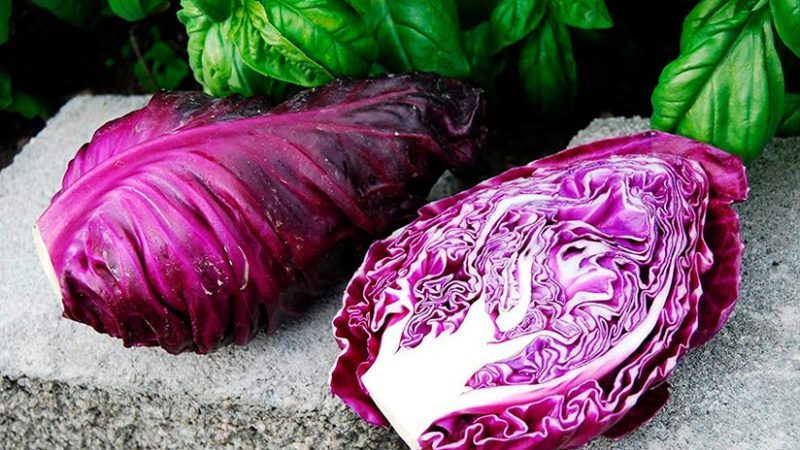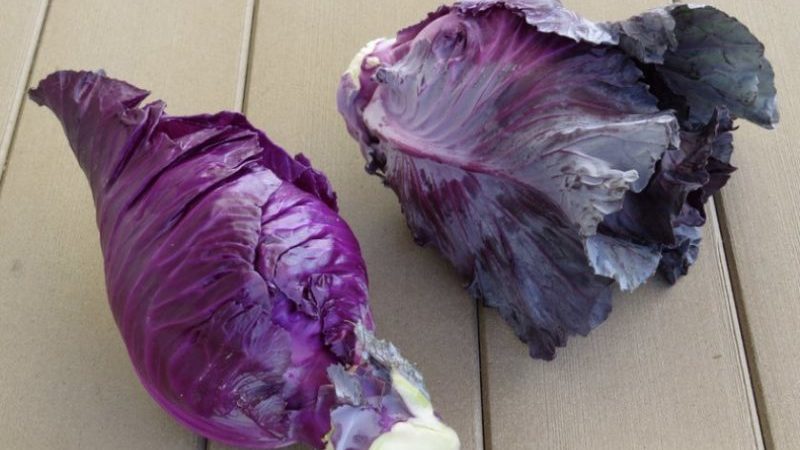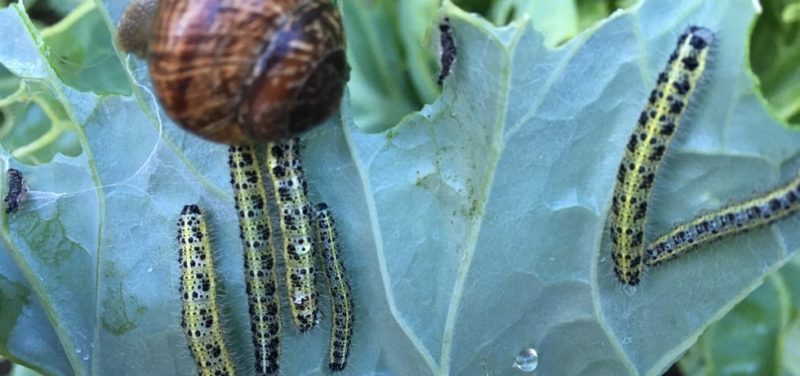Why is Kalibos cabbage good, how to grow it and where to use it
Cabbage Kalibos attracts the attention of vegetable growers not only with its original conical shape and bright color of heads, but also with its high productivity, unpretentiousness and pleasant sweetish taste.
The article will tell you about the advantages and disadvantages of the variety, the rules for its cultivation and the requirements that Kalibos makes for planting and care.
The content of the article
What is this cabbage variety

The Kalibos red cabbage belongs to the Czech selection line and is recommended for growing in garden plots, household and small farms. The forks are characterized by an unusual conical shape, sweet taste, suitable for fermentation and fresh consumption.
Brief history of origin and distribution
Kalibos is a red cabbage variety bred by Czech breeders of the Moravoseed company. Included in the State Register of Breeding Achievements of Russia in 1997 with admission to cultivation in all regions.
Feature and Description
This is a mid-season red cabbage variety. The crop reaches technical maturity 140-150 days after full germination. Marketable yield - 580-640 c / ha.
Appearance and taste

The Kalibos cabbage is a tall plant with a semi-vertical leaf rosette 30-40 cm high and 50-70 cm in diameter. Covering leaves of medium size, concave, slightly bubbly, medium wavy, dark red and broadly elliptical in shape, covered with a waxy bloom of medium degree. The height of the outer stump is 25-35 cm, the inner one is 15-20 cm.
The cultivar forms partly covered, medium-dense heads of cone shape, which reach 25-35 cm in length, 50-70 cm in diameter at the widest part and weigh 1.5-2 kg. The cross section of the fork is red-purple.
Kalibos is characterized by juiciness, sweet taste and delicate texture.
Resistant to temperatures
Seeds germinate even at a temperature of + 2 ... + 3 ° C, but at + 11 ° C, seedlings appear in 10-12 days, and at + 20 ° C - after 3-4 days.
Seedlings can withstand short-term frosts down to -6 ° C, heads of cabbage - up to -8 ° C. Prolonged exposure to temperatures above + 25 ° C negatively affects head formation.
Moisture and drought resistance
Hot weather and prolonged drought lead to an increased accumulation of nitrates in cabbage. Kalibos tolerates excessive moisture better - excess moisture does not provoke rotting or cracking of vegetables.
Disease and pest resistance
The variety is resistant to most diseases and pests characteristic of the culture, but it can be attacked by whiteflies, scoops and aphids.
It is interesting:
Description, cultivation, popular varieties of savoy cabbage
Scope of this variety of cabbage
Kalybos cabbage is consumed fresh, used for preparing salads and hot dishes, fermented, canning... Heads of cabbage are stored for no more than 4 months.
Advantages and disadvantages of the variety
The main advantages of Kalibos cabbage:
- abundant productivity;
- moisture and frost resistance;

- high taste;
- the possibility of universal use;
- amicable maturation;
- immunity to typical diseases;
- original appearance of the heads;
- high commercial qualities;
- unpretentiousness.
Disadvantages of the variety:
- exactingness to the composition of the soil, watering and dressing;
- short shelf life;
- the possibility of only manual harvesting;
- poor transport tolerance.
Growing technology
Kalybos cabbage is grown by seedling and seedling methods, the main thing is to take into account the climatic conditions of the region, choose the right site, comply with the planting dates and care requirements.
Optimal conditions
For planting, choose a well-lit, protected from gusty winds and drafts place with soil that has slightly alkaline (pH 7-7.5) or neutral (pH 6.5-7) acidity. The best option is clay or loamy soil.
The site is prepared in advance - it is cleaned of weeds and plant debris, dug onto a shovel bayonet and add 2 kg of humus and 2 tsp. nitroammofoski for every 1 sq. m.
The best predecessors are legumes, cucumbers, onions, potatoes, beets, tomatoes, and perennial herbs.
Important! In one and the same place, cabbage can be planted no earlier than after 4 years.
Terms and rules of landing
Seeds for seedlings are sown in early April. More precise terms are determined, focusing on the fact that seedlings are transplanted into open ground at the age of 40-45 days.
For disinfection, the planting material is pre-soaked for 25-30 minutes. in a solution of potassium permanganate, and then dipped into hot (no more than + 50 ° C) water to improve germination.
Sowing technology:
- Lay a layer of expanded clay or fine charcoal drainage in prepared containers with a depth of at least 7 cm.
- Pour a substrate suitable for seedling on top (humus, sod soil and low-lying peat with neutral acidity in a ratio of 2: 1: 1) and water it.
- Spread the seeds on the surface of the soil at a distance of 2-3 cm from each other, deepening them by 1-1.5 cm.
- Spray on them with a spray bottle a solution of potassium or sodium humate, sprinkle with a dry substrate (layer thickness - 0.5 cm).
- Cover containers with crops with polyethylene and remove to a warm (about + 20 ° C) place.
After emergence, polyethylene is removed, and the temperature is maintained at + 15 ... + 18 ° C during the day and + 8 ... + 10 ° C at night. The duration of daylight hours for seedlings should be at least 8-10 hours. If necessary, use fluorescent lamps for additional lighting.
Watering with a spray bottle is carried out as needed, without allowing the substrate to completely dry out, using settled water at room temperature.
In the cotyledon phase, seedlings are dived into individual containers, and a week before planting in open ground, they begin to harden, exposing them to the open air for several hours at a temperature of + 4 ... + 5 ° C and for the whole day at + 8 ° C.
The seedlings are fed twice: in the phase of 2 true leaves and 7-10 days before transplanting into the ground, using a solution of nitroammofoska (15 g per bucket of water) at the rate of 15 ml per plant for the first time and 50 ml for the second.
Transplanting seedlings into the ground is carried out at the end of May, when the seedlings reach a height of 19-21 cm and form 4-6 true leaves.
Landing rules:
- In the prepared area, form beds at a distance of 60 cm from each other.
- Every 50 cm, make planting holes in them about 15 cm deep.
- Pour 1.5 liters of water into each and add 150 g of wood ash.
- Place the seedlings in the holes together with an earthen clod, sprinkle with earth and water at the rate of 1-1.5 liters of water for each plant.
For seedless cultivation, seeds are sown in a greenhouse or greenhouse in early May.
Further care

Watering is carried out as needed, preventing the soil from completely drying out: it must be moistened to a depth of 2-2.5 cm.On average, cabbage is watered 8-12 times per season, focusing on the amount of precipitation and the climate of the region - the more it rains, the less often the plantings are watered.
Reference. Watering is carried out by sprinkling, using settled warm (+ 20… + 25 ° C) water.
After each watering or rain, the soil is carefully loosened to a depth of 4 cm in order to improve its moisture permeability, aeration and prevent the formation of a dry crust on the soil surface. At the same time, the soil is weeded, getting rid of weeds, which take moisture and nutrients from it and create favorable conditions for the development of diseases and pests.
Fertilizers are applied twice:
- 10-12 days after transplanting seedlings into the ground - 10 liters of nitroammofoska solution (2 tsp per 10 liters of water) per 1 sq. m;
- before closing the rows - 10-12 g of nitrophoska for each plant.
Hilling is carried out 2-3 times with an interval of 5-7 days at the initial stage of head formation, before the leaf blades close.
Possible problems, diseases, pests

The pests that can attack Kalibos are presented in the table.
| Pest | Signs | How to get rid of |
|---|---|---|
| Whitefly | The larvae of the pest suck out the juices of plants and leave behind a sweet liquid on which sooty mushrooms settle. | The plantings are treated with Zeta, Rovikurt, Fufanon, Fitoverm, Aktara, Confidor, Tanrek.
From folk remedies, infusions of dandelion, garlic, tobacco and soap solution help to get rid of pests. |
| Scoop | At the stage of seedling growth, the pest caterpillars gnaw the stems of the seedlings, the plants fall.
During the ovary of heads of cabbage, pests eat the flesh of the leaves, leaving only thick veins. |
Treatment with drugs "Dendrobacillin", "Bitoxibacillin", "Lepidocid", "Fitoverm", "Agravertin", "Fury" or decoctions of wormwood, tomato tops, bitter red pepper. |
| Aphid | The leaves become faded and brittle, yellow spots and a sticky, dirty coating appear on the plant. | Cabbage is treated with insecticidal preparations, for example, "Pyrethrum", "Karbofos" or "Iskra". |
Features of cultivation depending on the region
Kalibos cabbage is successfully cultivated in all regions of Russia. The variety tolerates low air temperatures and high levels of humidity well, so its basic care requirements do not change depending on the climate of the region.
Certain nuances lie in the need for more frequent watering in the southern regions, which are characterized by an arid climate, the timing and method of planting crops. So, in the middle lane, the seedling method is more often used, in the south - the seedless technology.
Reviews of summer residents

Farmers speak positively about the variety.
Elena, Moscow region: "This is a very tasty cabbage - sweet, juicy, tender, crunchy. Ideal for salads, but pickled, it is simply delicious. I used to plant only white cabbage all the time, now I can't imagine how you can do without Kalibos. "
Lyudmila, Moscow region: “I saw this cabbage at a neighbor's place and at first became interested in the variety only because of the unusual shape and bright color of the heads. But Kalibos surprised not only with its appearance, but also with its amazing sweet taste. Even children eat this cabbage with pleasure ”.
Olga, Bryansk region: “The variety is excellent - the heads of cabbage are beautiful, unusual in shape, very tasty, suitable for salads and for pickling. Care is not difficult, the yield is high. The only pity is that the heads of cabbage are not stored much - only a few months. "
It is interesting:
Simple but delicious recipes for marinated red cabbage
Simple and tasty ways to pickle red cabbage for the winter in jars
Conclusion
Kalibos is a mid-season red cabbage. The variety is characterized by unpretentiousness, abundant productivity, moisture and frost resistance, pleasant sweet taste and unpretentious care. Among the shortcomings, they note the exactingness of the soil composition, irrigation and fertilization, a short shelf life and the impossibility of mechanized harvesting.